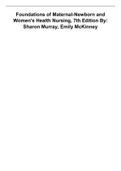Foundations of Maternal-Newborn and
Women's Health Nursing, 7th Edition By:
Sharon Murray, Emily McKinney
,Foundations of Maternal-Newborn
and Women's Health Nursing, 7th
Edition By: Sharon Murray, Emily
McKinney
,Contents
PART I: FOUNDATIONS FOR NURSING CARE
OF THE CHILDBEARING FAMILIES
1. Maternity and Women’s Health Care Today
2. Social, Ethical and Legal Issues
3. Reproductive Anatomy and Physiology
4. Hereditary and Environmental Influences on
Childbearing
PART II: THE FAMILY BEFORE BIRTH
5. Conception and Prenatal Development
6. Maternal Adaptations to Pregnancy
7. Antepartum Assessment, Care and Education
8. Nutrition for Childbearing
9. Assessing the Fetus
10. Complications of Pregnancy
11. The Childbearing Family with Special Needs
PART III: THE FAMILY DURING BIRTH
12. Processes of Birth
13. Pain management during Childbirth
,14. Intrapartum Fetal Surveillance
15. Nursing Care During Labor and Birth
16. Intrapartum Complications
PART IV: THE FAMILY FOLLOWING BIRTH
17. Postpartum Adaptations and Nursing Care
18. Postpartum Maternal Complications
19. Normal Newborn: Processes of Adaptation
20. Assessment of the Normal Newborn
21. Care of the Normal Newborn
22. Infant Feeding
23. High-Risk Newborn: Complications Associated with
Gestational Age and Development
24. High-Risk Newborn: Acquired and Congenital
Conditions
PART VI: WOMEN’S HEALTH CARE
25. Family Planning
26. Infertility
27. Women’s Health Care
,Chapter 01: Maternity and Women‘s Health Care Today
Foundations of Maternal-Newborn & Women‘s Health Nursing, 7th Edition
MULTIPLE CHOICE
1. A nurse educator is teaching a group of nursing students about the history of family-
centered maternity care. Which statement should the nurse include in the teaching
session?
a.
The Sheppard-Towner Act of 1921 promoted family-centered care.
b.
Changes in pharmacologic management of labor prompted family-centered care.
c.
Demands by physicians for family involvement in childbirth increased the practice of family-
centered care.
d.
Parental requests that infants be allowed to remain with them rather than in a nursery initiated
the practice of family-centered care.
ANS: D
2. Expectant parents ask a prenatal nurse educator, ―Which setting for childbirth limits
the amount of parent–infant interaction?‖ Which answer should the nurse provide for
these parents in order to assist them in choosing an appropriate birth setting?
a.
Birth center
b.
Home birth
c.
Traditional hospital birth
d.
Labor, birth, and recovery room
ANS: C
In the traditional hospital setting, the mother may see the infant for only short feeding periods,
and the infant is cared for in a separate nursery. Birth centers are set up to allow an increase in
parent–infant contact. Home births allow the greatest amount of parent–infant contact. The
labor, birth, recovery, and postpartum room setting allows for increased parent–infant contact.
DIF: Cognitive Level: Understanding OBJ: Nursing Process Step: Planning
MSC: Patient Needs: Health Promotion and Maintenance
3. Which statement best describes the advantage of a labor, birth, recovery, and
postpartum (LDRP) room?
a.
The family is in a familiar environment.
b.
They are less expensive than traditional hospital rooms.
c.
The infant is removed to the nursery to allow the mother to rest.
d.
The woman‘s support system is encouraged to stay until discharge.
ANS: D
Sleeping equipment is provided in a private room. A hospital setting is never a familiar
environment to new parents. An LDRP room is not less expensive than a traditional hospital
room. The baby remains with the mother at all times and is not removed to the nursery for
, routine care or testing. The father or other designated members of the mother‘s support system
are encouraged to stay at all times.
DIF: Cognitive Level: Understanding OBJ: Nursing Process Step: Assessment
MSC: Patient Needs: Health Promotion and Maintenance
4. Which nursing intervention is an independent function of the professional nurse?
a.
Administering oral analgesics
b.
Requesting diagnostic studies
c.
Teaching the patient perineal care
d.
Providing wound care to a surgical incision
ANS: C
Nurses are now responsible for various independent functions, including teaching, counseling,
and intervening in nonmedical problems. Interventions initiated by the physician and carried out
by the nurse are called dependent functions. Administrating oral analgesics is a dependent
function; it is initiated by a physician and carried out by a nurse. Requesting diagnostic studies
is a dependent function. Providing wound care is a dependent function; however, the physician
prescribes the type of wound care through direct orders or protocol.
DIF: Cognitive Level: Understanding OBJ: Nursing Process Step: Assessment
MSC: Patient Needs: Safe and Effective Care Environment
5. Which response by the nurse is the most therapeutic when the patient states, ―I’m so
afraid to have a cesarean birth‖?
a.
―Everything will be OK.‖
b.
―Don‘t worry about it. It will be over soon.‖
c.
―What concerns you most about a cesarean birth?‖
d.
―The physician will be in later and you can talk to him.‖
ANS: C
The response, ―What concerns you most about a cesarean birth‖ focuses on what the patient is
saying and asks for clarification, which is the most therapeutic response. The response,
―Everything will be ok‖ is belittling the patient‘s feelings. The response, ―Don‘t worry about it. It
will be over soon‖ will indicate that the patient‘s feelings are not important. The response, ―The
physician will be in later and you can talk to him‖ does not allow the patient to verbalize her
feelings when she wishes to do that.
DIF: Cognitive Level: Application OBJ: Nursing Process Step: Implementation
MSC: Patient Needs: Psychosocial Integrity
6. In which step of the nursing process does the nurse determine the appropriate
interventions for the identified nursing diagnosis?
a.
Planning
b.
Evaluation
c.
Assessment
d.
Intervention




